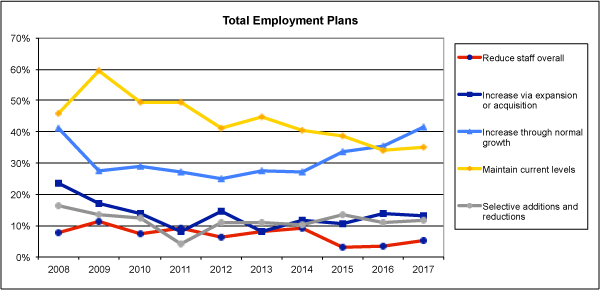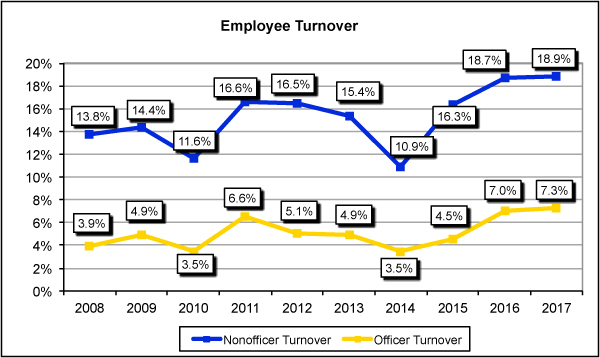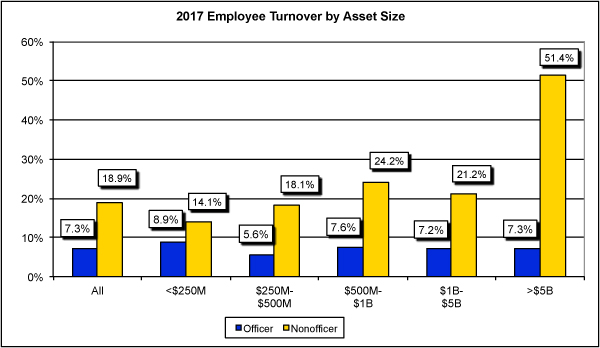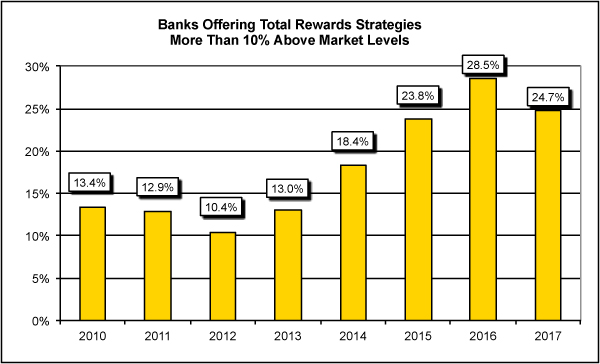Competition for talent pushes compensation changes
But bankers don’t work for pay alone
- |
- Written by Patrick J. Cole, SPHR, and Timothy J. Reimink
 This is the second part of a series presented annually by Crowe Horwath on BankingExchange.com in banking compensation trends.
This is the second part of a series presented annually by Crowe Horwath on BankingExchange.com in banking compensation trends.
The labor market for bank employees is very competitive, and likely to remain so as banks plan to grow and employee turnover rates remain high.
Banks plan for staff growth
Every year, Crowe Horwath LLP surveys financial services companies throughout the U.S. about compensation trends, benefits, incentives, and other human resource issues.
The results of the 2017 Crowe Bank Compensation and Benefits Survey show that, for the first time since the 2008-2009 recession, a majority of the participating banks plan to increase staffing levels during the coming year.
More than half of the survey respondents reported they plan to increase staffing levels during the coming year, while the number of banks planning to reduce staffing levels remains near all-time low levels.
Altogether, 54.9% of the survey participants said they plan to increase staff in the coming year, either in response to normal growth (41.7%) or as a result of expansions or acquisitions (13.2%).
The 2017 total represented a sizable increase from 2016, when 35.6% foresaw staffing increases due to normal growth, and 13.8% expected staffing increases due to expansions or acquisitions. (See Exhibit 1.)
Exhibit 1: Staffing plans
Source: 2017 Crowe Horwath LLP Bank Compensation and Benefits Surveys
In the longer term, three trends are particularly noteworthy:
1. The number of banks expecting staff expansions due to normal growth has been climbing steadily since 2012.
2. The number of banks expecting to maintain current staffing levels has been declining steadily since 2013.
3. The number of banks planning deliberate staff reductions dropped sharply in 2015—and has remained quite low since then.
Taken together, these concurrent trends suggest that the competition for talented employees is likely to remain relatively intense for the foreseeable future.
Employee turnover rates continue to rise
The ongoing battle for talented employees is reflected in another finding in the 2017 survey. Average employee turnover rates climbed for the third consecutive year in 2017, reaching their highest levels in more than a decade—7.3% average turnover for officers and 18.9% for nonofficers. (See Exhibit 2.)
Exhibit 2: Employee Turnover
Source: 2017 Crowe Horwath LLP Bank Compensation and Benefits Surveys
Higher employee turnover can be interpreted in a number of ways. Most obviously, it is a sign of a strong labor market and continued economic growth. At regional and national industry gatherings in recent months, a number of executives have commented on the increasing competition they are experiencing when recruiting nonofficer employees, particularly in customer-facing positions.
The competition comes not only from other banks, but also from retailers and other businesses who are under pressure to improve their customer-service capabilities.
In some markets, tellers with a moderate level of experience are actively targeted for recruitment by organizations offering higher pay and benefits, in exchange for working conditions that might be slightly less appealing than those experienced in the typical bank branch.
The survey responses suggest that turnover rates in nonofficer positions seem to be a particularly challenging issue in the largest banks. While nonofficer turnover rates in the 2017 survey were relatively consistent among small and midsized organizations, banks with more than $5 billion in assets reported an average turnover rate in excess of 50%—more than double the average among all other organizations. (See Exhibit 3.)
Exhibit 3: Employee Turnover by Asset Size
Source: 2017 Crowe Horwath LLP Bank Compensation and Benefits Survey
The higher turnover rates among larger banks might reflect the increased communication challenges large organizations face.
More ominously, however, the high turnover rates also might be an indication of low work engagement, stressful working conditions, or overall employee dissatisfaction.
Banks adjust compensation strategies to respond
With bank growth expectations and employee turnover levels both at high levels, upward pressure on employee salaries is inevitable. Banks can respond to these pressures in a variety of ways, but most human resource professionals recognize that simply boosting pay levels is not necessarily the best way to compete for talent.
When employees are asked to identify the best employers to work for, the companies that lead the way very often pay slightly below the median pay ranges in their industries and geographic markets. Rather than relying on base pay or cash incentives alone, those companies identified as “employers of choice” often opt to offer a broader package of inducements to attract and retain the best talent.
The 2017 survey responses seem to indicate banks increasingly are sensitive to this trend. Every year, participants are asked to assess their compensation strategies and compare them to those offered by their competitors. They are asked to characterize their total rewards packages—that is, the combination of salary, benefits, bonuses, and other financial incentives—and rate them as being more than 10% above the market average, within 10% of the market average, or more than 10% below the market average.
In 2017, the number of banks that characterized their total rewards strategy as being above-market declined slightly, reversing what had been a pronounced upward trend. (See Exhibit 4.) Prior to 2017, the use of above-market compensation strategies had been growing rapidly and steadily—in fact, the number almost had tripled over a span of just four years, climbing from 10.4% in 2012 to 28.5% in 2016.
Exhibit 4: Above-Market Compensation Strategies
Source: Crowe Horwath LLP Bank Compensation and Benefits Surveys
The reversal of the previous upward trend in the use of above-market compensation strategies could be interpreted as an indicator that salary pressures might start to moderate in the near future.
However, as noted earlier, overall employee turnover rates for both officers and nonofficers are still climbing, and a majority of executives in the survey expect they will be adding staff over the next 12 months.
These somewhat conflicting signals indicate that bank executives and particularly human resource executives— should remain alert to the shifting trends and should be prepared to revisit both their compensation packages and their broader employee retention strategies in the months to come.
About the authors
Timothy Reimink is managing director at Crowe Horwath LLP. You can reach him at 616-774-6711, [email protected]
Patrick Cole is senior manager at Crowe Horwath LLP. You can reach him at 630-586-5194, [email protected]
Read Part 1 of this series: "Bank salaries still growing, but future uncertain"
Next: Part 3 of this series: "Attracting and retaining tomorrow’s bank leaders"
Tagged under Human Resources, Management, Feature, Feature3,

















